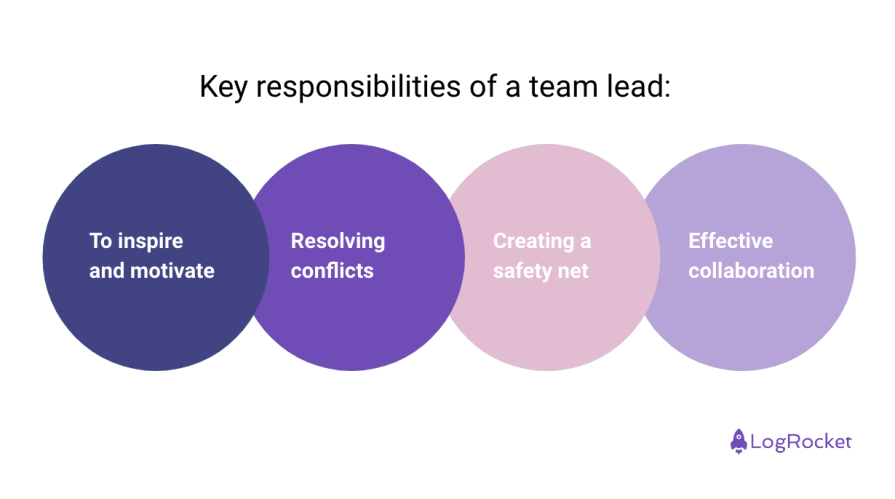Nowadays, people are more acquainted and conscious with prospective companies before accepting employment. While deciding where to work, people consider influential factors like company culture, a sense of purpose, leadership, etc. This marks a shift from before where competitive compensation was the most important driver of employment decisions.

The competitive market has opened up many employment opportunities, causing salary to lose some of its significance in employment decisions. More than ever, leadership plays a crucial role in any organization to attract and retain good talent. According to a survey by Talent Force in 2022, soft motivators are as essential for attracting the right talent as salary and compensation.
As a result, defining the leadership expectations is crucial for every organization. This goes beyond increasing efficiency and maximizing productivity. However, before diving into how to be an effective team lead, let’s quickly look at what a team lead is.
A team lead is a visionary who can coach, guide, and motivate the team to work collaboratively towards a common goal.
For every organization, the leaders are crucial at all levels. With highly competent individuals comes a variety of challenges like substantial opinions and an increased need to understand the purpose of one’s contributions. A team leader fills this need by serving as the bridge and communicating in both directions.
Although the leader and the manager roles may be entangled, a leader and a manager often differ at the core. The manager is responsible for organizing, planning, and coordinating resources to manage the deliverables. In contrast, leaders motivate, inspire, and influence people and drive them to achieve goals aligned with the bigger picture.
In agile methodologies, there’s a clear division where the competent lead focuses on resources, growth, and reporting, whereas in delivery organizations the product manager inspires, drives, and motivates people by sharing the vision, showing the impact of the deliveries.
Depending on the organization’s goal and the product teams’ mission, the aspects of an effective team lead might look different, with different strengths. Still, every team lead has a few primary responsibilities to accomplish an effective work environment where the teams can thrive and perform at their best.
Product managers or team leaders understand the big picture and identify the milestones to achieve the results. They are responsible for creating a roadmap, prioritizing the right things, ensuring the team focus is on track, and delivering products that contribute to the organization’s goal:

A leader who can inspire and motivate their team can make all the difference in achieving extraordinary success. When motivated and driven, a team is willing to go the extra mile to create a world-class product. To be genuinely inspiring, leaders must believe in the cause, communicate openly, and be honest with their team.
Teams working on innovative products require visionary team leaders who believe in their team’s ability to push through obstacles and work towards the common goal for the organization. When working on innovation or new product development, the exact direction may be undefined. Still, a good team leader understands that any obstacle is just a step in the learning and improvement process. Therefore, leaders must prepare their teams with an agile mindset, embrace change, and align goals to achieve successful results.
As a leader, one of the most challenging responsibilities is resolving conflicts in a healthy way. When working with a team of skilled individuals, disagreements over ideas and implementation can arise. However, creating a work environment where conflicts can be resolved collaboratively without blame, arguments, negative feedback, or harsh confrontation is crucial.
Fostering a positive atmosphere where people feel comfortable sharing new ideas and thoughts takes time, trust, and emotional maturity. Good leaders implement healthy ways to resolve conflicts. Some of these ways include active listening, where the leaders ensure there are no interruptions and allow the parties involved to express themselves freely. They also focus on the issue rather than the person involved in it. The leaders can take objective steps to resolve the conflict by depersonalizing the situation.
Additionally, clarifying expectations is crucial. Conflicts arise mainly when two parties have different expectations, and defining these expectations can help put things in perspective and resolve the conflict. As a leader, if you let the people come to a solution themselves, they will feel accountable for the solution rather than giving them a solution or imposing a process.
A leader must foresee and build different types of safety nets for their team to work smoothly, for example, by implementing a fail-safe mechanism for securing any breach, cultivating a culture of open communication, and providing psychological safety by acknowledging and promoting diverse perspectives. To be able to think outside the box and put forth their opinions and ideas, the team members need to feel secure in proposing those thoughts.
As much as acknowledging achievements and celebrating them is important, so are the opportunities to learn from setbacks. Promoting the culture of learning from failure helps build resilience and cultivates a growth mindset within the team. Moreover, recognizing and celebrating the team’s hard work and accomplishments can provide them with a sense of satisfaction and acknowledgment.
Effective collaboration is crucial for a team’s success. When team members enjoy working together, they are more likely to be open-minded and accepting of each other’s ideas, resulting in greater productivity and innovation.
A good leader recognizes the significance of fostering a collaborative environment and takes responsibility for creating such an atmosphere. One way to promote effective collaboration is by encouraging open communication and using appropriate tools to showcase the team’s progress and impact transparently. Investing time in team-building activities and facilitating collaborative decision-making are some other ways to establish effective collaboration.
A good team leader possesses diverse skill sets, some acquired through experience and others built into their personality and mindset. Here are the essential skills that make up a good team leader:

Communication is a key to being successful in any role. For a team lead, communication is the key to creating transparency, openness, and an ideal collaborative environment at work.
Effective communication is a skill that is learned and mastered over the years. Some leaders are naturally charismatic in communication, while others might need to conjure the art of storytelling. Regardless, setting up a good process and using the right tools to create transparency is the perfect way to balance the communication scale.
Empathy and emotional intelligence are essential traits distinguishing great bosses from the rest. Being empathetic is vital to understanding the issues and emotions involved in a situation.
Emotional intelligence lets you depersonalize the problem from the person, allowing you to focus on finding solutions. Empathy naturally leads to other qualities, such as active listening, constructive feedback mechanisms, and conflict resolution techniques, all of which are crucial for success as a team leader.
A leader has to make decisions regularly. Weighing the pros and cons, identifying the best solution, and prioritizing the right thing is the key to making an informed decision. Decision-making gets easier with time since navigating different scenarios becomes a natural part of your thinking process. Making decisions is not the tricky part. The challenge is in analyzing all the data and information. The leader needs the right mindset, solution orientation, strategic thinking, and negotiation skills to interpret the information.
Change is the only constant in this fast-evolving world. A leader must also constantly change their leadership styles based on the situation. Sometimes, they need to be inspirational and motivated and give autonomy to the team to create innovative products. In contrast, other times, they need to set clear directions and commands for delivering on deadline or security requirements.
Leaders plan the roadmap and foresee the milestones but must be adaptive and considerate of the changing market desirability or team feasibility. The faster leaders can adapt, the better they can equip themselves to manage the situation. Hence, adaptability and agility are skills that give a leader an edge.
The role of a leader is complex and challenging yet worthwhile in the end. The most common challenges faced by team leads are:
The teams responsible for product development are often under pressure to meet deadlines and are always busy. However, it’s worth taking the time to engage in team activities and kick-offs, even with time constraints. These activities help team members get to know each other better and create a bond among the team.
Once this bond is formed, it becomes easier to collaborate, share new ideas, provide feedback, and even challenge each other constructively. As a leader, investing in these collaborative efforts is the best way to create a harmonious working environment.
A team lead can consider embracing change through collaboration. Changes in an organization, whether big or small, can lead to uncertainty and resistance. However, collaborating effectively with those involved and affected by the change can reduce resistance and increase willingness to adapt. Involving everyone in the change process can lead to a smoother transition.
The third and most essential way to be an excellent team leader is to delegate. Delegation creates accountability and when people feel accountable for something, they tend to follow through with their responsibilities thoroughly. To delegate effectively, a team leader must trust their team members to stick to their commitments independently.
As a team leader, your role is to guide, coach, and inspire your team towards achieving a common goal collaboratively. Fostering a collaborative environment, resolving conflicts, establishing transparency, and creating a safety net for the team are some of your primary responsibilities.
To be effective in your role, you need to possess specific skills such as excellent communication, higher emotional intelligence, empathy, vision, decisiveness, and agility. However, it’s essential to keep in mind that managing people is complex yet gratifying. As a team leader, you may encounter some challenges, such as resistance to change, managing expectations, and balancing priorities.
With time and experience, you can master these skills, navigate the complex team dynamics, promote a positive work culture, and lead your team to tremendous success.
Featured image source: IconScout

LogRocket identifies friction points in the user experience so you can make informed decisions about product and design changes that must happen to hit your goals.
With LogRocket, you can understand the scope of the issues affecting your product and prioritize the changes that need to be made. LogRocket simplifies workflows by allowing Engineering, Product, UX, and Design teams to work from the same data as you, eliminating any confusion about what needs to be done.
Get your teams on the same page — try LogRocket today.

A practical five minute revenue estimation method to help product managers compare ideas, drop low impact features, and prioritize smarter.

A practical guide for PMs who want to stop being bottlenecks, delegate smarter, and lead teams effectively with a clear ownership framework.

Stop letting unreliable data block features. Treat data as inventory to track quality, ownership, and ship with confidence.

Learn why slide decks slow teams down and explore better tools like whiteboards, PRDs, and prototypes to improve collaboration and alignment.